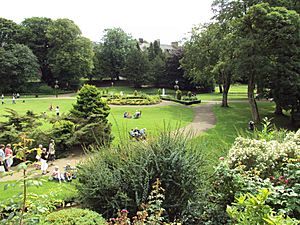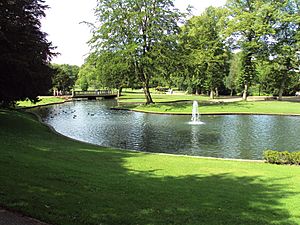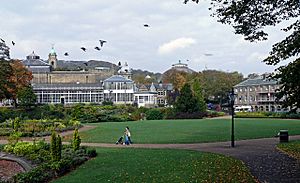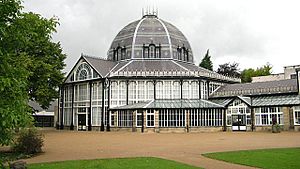Buxton Pavilion Gardens facts for kids
Quick facts for kids The Pavilion Gardens |
|
|---|---|
| formerly Serpentine Walks | |

Milner Bridge over River Wye and Bandstand
|
|
| Location | Buxton, Derbyshire |
| Area | 14 hectares (35 acres) |
| Elevation | 300m |
| Created | 1871 |
| Designer | Edward Milner |
| Designation | Grade II* Listed Park |
The Buxton Pavilion Gardens is a beautiful public park in the spa town of Buxton, Derbyshire. It was designed in the Victorian era and is a special place with lots of history. The River Wye flows right through the gardens. This park is so important that it's listed as a Grade II* park of Special Historic Interest.
Contents
What Can You See and Do at Pavilion Gardens?
The Pavilion Gardens cover about 9.5 hectares (23 acres) in the valley of the River Wye. Two smaller streams also run through the park. The northern stream has pretty waterfalls and goes under footbridges. The southern stream connects three lakes, and the last one has a fountain. The whole park area, including the nearby Serpentine park and Branksome Woods, is about 14 hectares (35 acres).
In 2004, the gardens got a big makeover, costing £3.3 million. New things were added, like a Victorian-style bandstand. This bandstand is used for summer concerts and even weddings! You can also find fun play areas, an outdoor gym, and a miniature railway ride for kids. Inside the main pavilion building, there's a café, an ice cream shop, a visitor shop, and an art gallery. The Buxton Cinema is in the Pavilion Arts Centre next door. There's also an indoor swimming pool and fitness center that looks out over the gardens.
Wildlife in the Park
The river, lakes, trees, and plants make the gardens a perfect home for many birds. You might see native ducks, Muscovy ducks, mandarin ducks, tufted ducks, and Canada geese. Other birds include moorhens, coots, goosanders, wrens, nuthatches, finches, and herons. The river is also home to brown trout, water voles, and crayfish.
In 2015, a famous author named Bill Bryson said that the Pavilion Gardens "must be the most delightful town park in the country."
A Look Back: The History of the Gardens
The park was designed by Edward Milner for the Buxton Improvements Company. This happened after the railway came to Buxton in 1863, making it easier for people to visit. The gardens first opened in August 1871. They were built on 12 acres of land given by the 7th Duke of Devonshire. By 1876, the park grew to its current size of 23 acres, including the lakes.
Originally, you had to pay to enter the gardens through a ticket office with turnstiles. Milner's design improved on an earlier landscape design from the 1830s called the Serpentine Walks. These walks were along the River Wye and were designed by Joseph Paxton for the 6th Duke of Devonshire. Milner replaced the old wooden bridges with fancy iron footbridges, and the main one is now called the Milner Bridge.
King Edward VII and Queen Alexandra visited the Pavilion Gardens in January 1905. During World War I, soldiers from the Royal Engineers used the park's lakes for training. They practiced building pontoon bridges there. In 1927, the local council took over running the Pavilion Gardens.
The Ancient Temple Base
There's an old platform in the gardens that is all that's left of an ancient Celtic temple. In 1755, people described it as having an eight-sided base. It was thought to be dedicated to a goddess of horses or, more likely, a goddess of healing waters. When Edward Milner redesigned the gardens in 1871, this 2,000-year-old temple was taken down. Only its base remains today.
Important Buildings Around the Gardens
Several beautiful Victorian buildings overlook the gardens from the north side. There's a wide walkway in front of them.
The Pavilion and Conservatory
The main Pavilion and Conservatory buildings are made of cast-iron and glass. They were built in 1870 and designed by Milner to look like London's famous Crystal Palace. The central hall of the Pavilion, which is now the café, had to be rebuilt in 1983 after a fire. The Conservatory was once a small concert hall. In 1982, it was changed into a greenhouse with tropical plants and a fish pond.
The Octagon Concert Hall
The Pavilion was made bigger in 1875 with the addition of the Octagon Concert Hall, designed by Robert Rippon Duke. This large hall can hold 800 people. Over the years, it has been used for music concerts, tea dances, conferences, and markets. Even The Beatles played here twice in 1963! The Octagon reopened in 2018 after a three-year, £3 million renovation.
Buxton Opera House
At the northeast corner of the gardens is the Buxton Opera House, built in 1903. It's the town's main theatre and has 900 seats. It was used mostly as a cinema from 1932 until it closed in 1976. After being restored, it reopened for stage shows in 1979. Since a full renovation in 2001, it has a busy schedule of plays, concerts, comedy, dance, opera, and pantomime. It also hosts the yearly Buxton Festival.
Pavilion Arts Centre
Inside the main pavilion complex, the Pavilion Arts Centre on St John's Road has a theatre with 360 seats. It has been the home of the Buxton Cinema since 2017. This building was originally built as the Entertainment Stage theatre in 1889. A very famous violinist, Niccolo Paganini, performed at an earlier theatre on this site in 1833.
Fun Activities and Walks
The indoor swimming pool and gym next to the Octagon were finished in 1972. Princess Anne officially opened them.
The Pavilion Gardens used to offer many leisure activities. You could play tennis and croquet, go boating on the largest lake, and roller skate. In winter, people could even go curling and ice skating on an ice rink where the car park is now. Tennis tournaments were held here from 1884 until the 1950s.
In 2019, boating was brought back to the main lake, which is great fun!
The Pavilion Gardens is also the starting point for the Dane Valley Way footpath. The Peak District Boundary Walk also goes through the gardens.
Other historic parks in Buxton include Ashwood Park and The Slopes.
Images for kids







